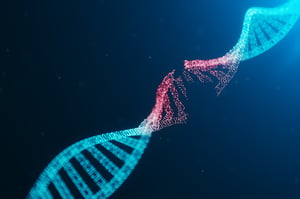Since the first published article mentioning the use of a rat as a small laboratory model in 1856, rodent models have helped advance critical biomedical research and enhanced drug discovery solutions. Andrew Brown, MS, MBA, Director of Commercial Development at Inotiv, recently shared his insights on the role of standard rodent models along with the historical development of custom model generation through transgenics.The value of standard models

Before molecular genetics were widely understood, selective breeding helped enhance selected traits that were naturally present in a species. “Standard or so-called ‘wild-type’ models have an unmodified genome,” explained Andrew. “While these models may be inbred or outbred to have certain traits, they are not considered transgenic because no new genetic material is introduced.” As readily-available models offered in multiple strains and large quantities by various providers, most common standard rodent models include:
Traditional laboratory models have been effective in modeling human disease, but modern genetic modification techniques provide a more accurate recapitulation of human disorders.
Major advances in gene-editing started in the 1970s with ethylnitrosurea (ENU)-induced chemical mutagenesis, which mainly causes base substitutions in DNA. In the 1980s, DNA microinjection, where DNA is inserted randomly at one or more genomic loci in a fertilized zygote, was also explored along with other approaches, like gene targeting in mouse embryonic stem (ES) cells in mice to knockout specific genes.
While these gene-editing technologies are still in use and have expanded researchers' understanding of gene function in normal and disease phenotypes, they also helped pave the way to develop new approaches.
Zinc-finger nucleases (ZFNs)
As mice were being genetically modified in the 1980s, the same research in rats occurred about a decade later.
“With the advent of embryonic stem cells for the mouse and the ease of genome manipulation as compared to rats, the mouse was initially the preferred research model for transgenics,” said Andrew. “The rat was harder to manipulate and the embryonic stem cells available in the rat weren't as reliable as the mouse.”
However, nuclease-based technologies offered more opportunities for both the mouse and the rat. Zinc-finger nucleases (ZFN) are one type of nuclease-based technology, where the zinc-finger, a DNA-binding component, along with a nuclease, induces a double-strand break at a specific genomic loci.
“Nuclease-based technologies can provide precision modification of all mammalian genomes with low off-target effects, reducing the number of animals required to establish a founder,” explained Andrew.
With these technologies, many “firsts” in transgenic rodent models were soon achieved by Inotiv in its former organization as SAGE Labs under Sigma-Aldrich. These first breakthroughs included:
- First Knockout Rat – Science 2009 325(5939): 433
- 6-month Knockout Mouse – Genetics 2010 186(2): 451-9
- First Knock-in Rat – Nat Biotechnol 2011 29(1): 64-7
- First Conditional Knockout Rat – Nat Methods 2013 10(7): 638-40
“ZFN and the mapping of the rat genome was a catalyst for change that allowed for modification in the rat genome,” he said. “However, while this groundbreaking gene-editing technology that now includes CRISPR for both mice and rats, the mouse is still the predominant species used in rodent research with the rat slowly catching up.”
With this history and knowledge obtained over the last decade, the team at Inotiv has developed a track record of reliable custom model generation.
“Nuclease-based technologies, like ZFN and CRISPR, have allowed research models to express the human version of genes so we can create models that are more representative of what is seen in humans,” said Andrew.
Pushing the limits of CRISPR
“Our internal research and development scientists continue to find new ways to optimize our processes as we perform large deletions and work to increase the size of our genetic insertions. CRISPR does have known limitations with insertion size but we’re working to push these limits. Two examples of recent success are our achievements of a 1.5Mb deletion and a 15kB insertion,” shared Andrew.
“This work is important for humanization projects, because human genes are quite large compared to rodents but are similar in terms of genetic makeup. Ultimately, we hope this foundational work will enable researchers to further understand disease and bring more effective drugs to the market.”
Philipeaux, J. (1856). Note sur l’extirpation des capsules surrénales chez les rats albinos (Mus ratus). C. R. Acad. Sci. 43, 904–906.
Russell, W. L., P. R. Kelly, P. R. Hunsicker, J. W. Bangham, S. C. Maddux, and E. L. Phipps. 1979. Specific locus test shows ethylnitrosourea to be the most potent mutagen in mouse. Proc. Natl. Acad. Sci. USA 76:5918-5922
Chen Y, Yee D, Dains K, Chatterjee A, Cavalcoli J, Schneider E, Om J, Woychik RP, Magnuson T. Genotype-based screen for ENU-induced mutations in mouse embryonic stem cells. Nat Genet. 2000 Mar;24(3):314-7. doi: 10.1038/73557. PMID: 10700191.
Jones D. Genetic engineering of a mouse: Dr. Frank Ruddle and somatic cell genetics. Yale J Biol Med. 2011 Jun;84(2):117-24. PMID: 21698043; PMCID: PMC3117405.


